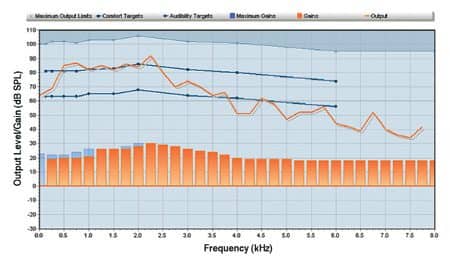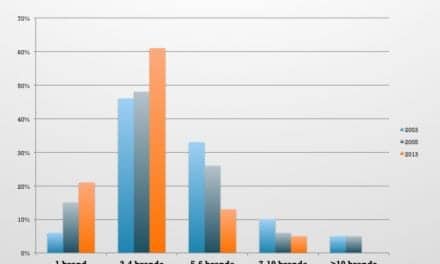Editor’s Note: This article was originally intended for HR’s February-March special editions on Music and Hearing Aid Design, co-edited by Marshall Chasin, AuD, and Larry Revit, MA. However, due to space limitations, we were forced to postpone its publication until this month. HR apologizes for this delay.

|
| Justin A. Zakis, PhD, is a Senior Engineer who leads the research program and Bernadette Fulton is a Principal Audiologist at Dynamic Hearing Pty Ltd, Richmond, Victoria, Australia. Correspondence can be addressed to Justin Zakis at . |
Hard-of-hearing musicians have special needs that are not always met by hearing aid technology. This article illustrates how clinical choices, state-of-the-art digital signal processor (DSP) systems, and advanced DSP software engineering improved the music listening experience for three musicians. The interplay between audiology and engineering is presented as a dialogue between an Dispensing Professional and a DSP software development Engineer.
Dispensing Professional Most of the hearing-impaired people I have fitted with hearing aids report that music sounds good, and almost all report that they prefer to listen to music while wearing their hearing aids. Musicians are often the exception. They express disappointment in their experience of listening to music with hearing aids. They sometimes express anger with the device and frustration with their hearing. I would like to discuss whether digital signal processing in digital hearing aids has the potential to improve the performance of hearing aids for musicians.
Engineer Digital hearing aids, like CD players, use digital representations of sound, but the sampling frequencies are usually lower (16 kHz compared to 44.1 kHz). A very low power DSP performs mathematical computations that are described in software (algorithms) to provide amplifier gain, filtering, feedback cancellation, adaptive directionality, and other features you see in today’s top-end hearing aids. Recent advances in hearing aid DSP computing capability have enabled higher sampling frequencies, greater dynamic range, and more sophisticated algorithms, providing musicians with high-fidelity sound and important features such as feedback cancellation.
Dispensing Professional You mentioned the sampling frequency. What impact does this have for musicians?
Engineer The highest sound frequency that can be amplified by a digital hearing aid is equal to half the sampling frequency. For example, an aid with a sampling frequency of 16 kHz will only amplify sounds up to 8 kHz, although more advanced aids are now capable of much higher frequencies. In practice, the frequency bandwidth of most aids is limited by the receiver, which can roll off from just 4-5 kHz. Wideband receivers can deliver twice this bandwidth. Since musical sounds cover the full range of human hearing, up to 20 kHz, there is room for additional improvement in future hearing aids.
Dispensing Professional Music is usually significantly louder than speech as an input to a hearing aid. What are the features to look for in a digital aid to avoid distortion of loud inputs?
Engineer There are three areas that are important in a hearing aid and directly contribute to improved rendering of music:
- The aid’s input circuitry (that takes the signals from the microphone(s) and then creates a digital representation of the sound);
- The computing precision of the DSP; and
- The receiver output performance.
For music, Chasin1,2 recommends hearing aids with input circuitry that can handle peak input levels of at least 105 dB SPL, preferably 115 dB SPL, without clipping. The input circuitry should also handle the dynamic range of music, which can be 100 dB.3
The DSP needs to be able to process the digitized sound with accuracy. The precision in a DSP circuit is expressed by the number of bits it is capable of using to process the digitized sound. More bits increase the range of values that can be processed, and increase the precision in the algorithm computations.
Most aids today use 16-bit DSP precision, equating to a 96 dB range of values, which falls outside the recommended music range. But that is changing. The Ezairo 5900 hearing aid DSP from ON Semiconductor, for example, can manage a 110 dB dynamic range right at the input circuitry level. Its DSP uses 24-bit precision, which is capable of processing a 144 dB range of values, which gives it high precision and computational “headroom” for complex algorithms. Finally, the receiver should have a saturation level that is above the output limits set in the fitting software across as wide a bandwidth as possible.
Dispensing Professional I can find out about the receiver response in a test box. The other things you’ve mentioned involve sampling frequency and the precision of the DSP. How can dispensing professionals like me find this information for the device they’ve selected for a musician?
Engineer Unfortunately, this information can’t be accurately determined with simple test box measures. You have to rely on manufacturers to provide this information.
Dispensing Professional A pianist I have worked with has a moderate notch-shaped loss around 4 kHz and good hearing elsewhere. She was fitted with hearing aids using wide dynamic range compression (WDRC) amplification with 6 channels, and was very dissatisfied with the sound quality of music, even with the slower time constants selected. After rejecting these hearing aids, she was fitted with hearing aids using ADRO® (Adaptive Dynamic Range Optimization) amplification. The hearing aids had 32 channels and used very slow time constants. For music, the adaptive directional microphone and feedback suppression were turned off, and the ADRO fitting was flattened across channels, which included increasing the gain by 3 dB in the 5 channels from 125 to 1000 Hz. She reported a fuller sound quality with these hearing aids. She also reported that she now preferred to listen to music with her hearing aids. Do you think the outcome was related to the fine adjustments that were possible in the low frequencies, the slower time constants, the increased number of channels, or some other aspect of the aid?
Engineer All of these factors probably contributed to the improved sound quality. The narrow low-frequency channels helped with fine tuning since this is where musical octaves and the ear’s critical bands both get smaller. A high number of channels allow more precise tailoring of the fitting to the audiogram.
ADRO amplification4 also deals with several of the problems identified by Chasin1 for listening to music. First, ADRO uses very slow time constants of about 10 seconds (ANSI S3.22), which preserves linearity between musical notes and fast temporal modulations across channels. Second, ADRO uses comfort targets, which may be viewed as output-level kneepoints that in terms of loudness have a fairly flat shaping across channels. For loud music, it slowly reduces the gain in each channel so that the channel’s output level exceeds its comfort target no more than 10% of the time. This makes loud music comfortably loud.
ADRO also has audibility targets that are about 20 dB below the comfort targets. For soft music, it aims to slowly increase the gain so that the output level exceeds the audibility targets at least 70% of the time (lower levels are assumed to be noise). The gain cannot be increased above the maximum gain, which avoids over-amplification of background noise. If the music is between soft and loud, ADRO does not adjust the gain, which preserves linearity.
The very slow time constants ensure that the dynamics between musical notes are not compressed, and that fast temporal envelope modulations are not distorted. The effect is like slowly adjusting a graphic equalizer in a recording studio to optimize the average loudness for the individual hearing loss across the channels. Finally, ADRO’s input-output function around the targets is the same across all channels, which retains the loudness balance of music across a wide range of input levels.
Dispensing Professional I was concerned about a country/rock singer who has a moderate U-shaped hearing loss. He likes to play his music loud, and has resisted hearing aids. He was fitted with an ADRO ultra-low-delay open-ear BTE, which had a processing delay measured as 1.3 ms in a test box. This delay could help with acceptance, since Stone and Moore’s data5 suggest that processing delay would be more disturbing when the gains are low or vary considerably with frequency, such as in an open-ear aid, and that delays of 1-2 ms can be less disturbing than longer delays. The musician liked the sound of the aid, which he described as clear and bright. How have engineers managed to reduce delays from as high as 10 ms6 over the last 5 years?
Engineer The reduction in delay has been possible due to increased computing capability—while maintaining low battery current—available in state of the art hearing aid DSPs. In the past, limited computing capability forced engineers to use simpler mathematics that, besides from delaying the audio, could also result in the generation of audible harmonics for tonal inputs. Some of today’s DSP aids use more complicated mathematics that result in minimal delay and have very low total harmonic distortion to the benefit of musicians. There is another benefit: the smaller the delay, the fewer frequencies where feedback and metallic sub-oscillatory ringing can most easily occur. These danger frequencies are multiples of the reciprocal of the loop delay (which is approximately equal to the processing delay). So for a delay of 5 ms these frequencies are at multiples of 200 Hz, and for a delay of 1.3 ms they are at multiples of 769 Hz.
Dispensing Professional The country/rock singer wears a broad-brimmed hat, so feedback control was essential with an open-ear aid, but he also plays the harmonica so I was concerned about possible feedback canceller (FBC) artifacts. The aid had a feedback management system comprising a slow-adapting FBC plus fast feedback suppression to control sudden instances of feedback. The feedback suppression operated only in quieter conditions, and could be set up to have multiple notches to avoid the notch-hopping problem described by Chung.7 He had no feedback when he wore his hat and had his hearing aid on, but reported just an occasional artifact, although he didn’t find it bothersome. Where do these artifacts come from?
Engineer The classic entrainment artifact is due to the FBC confusing a constant tonal input with feedback, and trying to remove the tone from the aid’s input. This causes the amplitude (or level) of the tone to vary over time, and the slower the FBC adapts, the longer it takes for this artifact to develop. In general, slow-adapting feedback cancellers are less likely to distort brief musical sounds than faster FBCs, but as the client found, they can still distort sustained tonal sounds.
Dispensing Professional I have noticed that some newer feedback cancellers do not produce the classic entrainment artifact, but they do produce a different artifact that sounds like the addition of vibrato to tonal inputs (an interesting consequence for musicians!). Why do some FBCs do this?
Engineer One way to stop the FBC from trying to cancel a tone is to vary the tone’s phase or frequency over time. If the phase or frequency varies faster than the FBC can adapt, then the FBC is in effect chasing the tone and can’t catch up with it in time to cancel it. But this is simply replacing one artifact with a potentially less objectionable artifact, which is the vibrato sound you describe.
Dispensing Professional I recently fitted a musician who is a conductor of an orchestra with ultra-low-delay ADRO hearing aids that had a brand-new “Dynamic” FBC (DFBC) that does not entrain or add vibrato to tonal inputs. He has a flat moderate hearing loss that required feedback control. He did not report any artifacts or distortion while listening to music and the feedback was well controlled. What does the DFBC do differently to other FBCs?
Engineer The DFBC (developed by Dynamic Hearing) is a good example of how DSP technology can be used to provide key improvements for musicians. It is a new design that inherently adapts in a way that is unaffected by tones, so it cannot be entrained. Instead of modifying the input signal to trick the FBC, or slowing or even stopping adaptation with music, the DFBC design can use a fast adaptation rate to quickly avoid whistling when the feedback path changes without introducing artifacts.
Dispensing Professional The conductor usually wears WDRC hearing aids. He is disappointed that he cannot hear the two bass strings of his violin (G = 196 Hz and D = 294 Hz) and that he cannot hear these and similar notes when listening to other musicians play.

|
| FIGURE 1. A screenshot of the Dynamic Display feature with the ADRO fitting of the situation with the orchestra conductor. The orange line shows the hearing aid’s instantaneous output level during a passage of classical music dominated by violins. The output limits (light blue line), comfort targets (upper dark blue line), and audibility targets (lower dark blue line) are shown at audiological frequencies. The adapted gain in each of the 32 channels is shown by the orange bars, with blue shadows showing the maximum gain. ADRO has slightly reduced the gain in some lower-frequency channels so that the output exceeds the comfort targets no more than 10% of the time, which ensures the lows are comfortably loud. The gain is at the maximum in the high frequencies to make the softer high-frequency harmonics audible. |
When fitting his new hearing aids, I wanted to fine tune a program to music instead of speech. The musician provided a recording of music he knew well. I increased the thresholds of ADRO’s fast output limiters to be 20 dB above the comfort targets to avoid limiting the peaks, due to the high crest factor of classical music (the limits were still at safe levels). Listening to the orchestral recording at a realistic volume, he could describe the sound quality. The fitting software had a “Dynamic Display” screen (Figure 1) that showed the output level and gain in each channel relative to the comfort targets, audibility targets, output limits, and maximum gains. This was really useful when fine tuning, since I could see what was happening in the aid as the musician heard the music through the device. I increased the maximum gain in the 20-125 Hz channel so he could hear softer bass notes, and flattened the maximum gains in the other channels to give a good tonal balance. I could check that the signal peaks remained under the output limiter thresholds, and the ADRO gains were usually near the maximum (giving a linear response in the hearing aid), except for very loud passages where the gains were reduced to avoid uncomfortable loudness. Wearing his new hearing aids, he was pleased to be able to hear the open G string on his violin, a sound he hasn’t heard for some time.
Unless the sound is perfect to their ear, I know that the musicians I have worked with will continue to be dissatisfied when listening to music. What can we expect from DSPs in the future to help musicians with their hearing loss?
Engineer We can expect the computing capability of hearing aid DSPs to continue to increase, while maintaining low current consumption. For musicians—and indeed for all hard-of-hearing people—this means further improvements in sound quality will emerge. High precision DSP circuitry will improve the precision of algorithms, which will enhance existing features and enable new features that audiologists will be able to use interactively to provide better outcomes for their clients.
Acknowledgements
The authors thank the three musicians highlighted here and the audiologists at Dynamic Hearing, especially Christi Miller and Jutta Hau. We would also like to thank Marc Niklaus of ON Semiconductor and Peter Blamey, PhD, of Australia Hears for their comments.
References
- Chasin M, Russo FA. Hearing aids and music. Trends Amplif. 2004;8(2):35-47.
- Chasin M. Hearing aids for musicians. Hearing Review. 2006;13(3):24-31.
- Chasin M. Music as an input to a hearing aid. Available at: www.audiologyonline.com/articles/article_detail.asp?article_id=1759; Accessed January 15, 2009.
- Blamey PJ. Adaptive dynamic range optimization (ADRO): A digital amplification strategy for hearing aids and cochlear implants. Trends Amplif. 2005;9:77-98.
- Stone MA, Moore BCJ, Meisenbacher K, Derleth RP. Tolerable hearing-aid delays. V. Estimation of limits for open canal fittings. Ear Hear. 2008; 29:601-617.
- Dillon H, Keidser G, O’Brien A, Silberstein H. Sound quality comparisons of advanced hearing aids. Hear Jour. 2003;56(4):30-40.
- Chung K. Challenges and recent developments in hearing aids: Part I. Speech understanding in noise, microphone technologies and noise reduction algorithms. Trends Amplif. 2004;8(3):83-124.
Citation for this article:
Zakis J, Fulton B. How Can Digital Signal Processing Help Musicians? Hearing Review. 2009;16(5):44-48.





